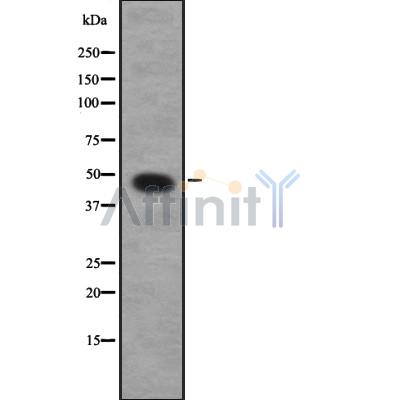CASQ2 Antibody - #DF8008
| Product: | CASQ2 Antibody |
| Catalog: | DF8008 |
| Description: | Rabbit polyclonal antibody to CASQ2 |
| Application: | WB IHC IF/ICC |
| Reactivity: | Human, Mouse, Rat, Monkey |
| Prediction: | Zebrafish, Bovine, Horse, Sheep, Rabbit, Dog, Chicken |
| Mol.Wt.: | 46 kDa; 46kD(Calculated). |
| Uniprot: | O14958 |
| RRID: | AB_2841385 |
Related Downloads
Protocols
Product Info
*The optimal dilutions should be determined by the end user. For optimal experimental results, antibody reuse is not recommended.
*Tips:
WB: For western blot detection of denatured protein samples. IHC: For immunohistochemical detection of paraffin sections (IHC-p) or frozen sections (IHC-f) of tissue samples. IF/ICC: For immunofluorescence detection of cell samples. ELISA(peptide): For ELISA detection of antigenic peptide.
Cite Format: Affinity Biosciences Cat# DF8008, RRID:AB_2841385.
Fold/Unfold
AA033488; AW146219; Calsequestrin 2 (cardiac muscle); Calsequestrin 2 fast twitch cardiac muscle; Calsequestrin; Calsequestrin cardiac muscle isoform; Calsequestrin fast twitch cardiac muscle; Calsequestrin-2; Calsequestrin2; cardCSQ; Cardiac calsequestrin 2; cardiac muscle isoform; CASQ 2; CASQ2; CASQ2_HUMAN; cCSQ; ESTM52; FLJ26321; FLJ93514; PDIB2;
Immunogens
A synthesized peptide derived from human CASQ2, corresponding to a region within the internal amino acids.
- O14958 CASQ2_HUMAN:
- Protein BLAST With
- NCBI/
- ExPASy/
- Uniprot
MKRTHLFIVGIYFLSSCRAEEGLNFPTYDGKDRVVSLSEKNFKQVLKKYDLLCLYYHEPVSSDKVTQKQFQLKEIVLELVAQVLEHKAIGFVMVDAKKEAKLAKKLGFDEEGSLYILKGDRTIEFDGEFAADVLVEFLLDLIEDPVEIISSKLEVQAFERIEDYIKLIGFFKSEDSEYYKAFEEAAEHFQPYIKFFATFDKGVAKKLSLKMNEVDFYEPFMDEPIAIPNKPYTEEELVEFVKEHQRPTLRRLRPEEMFETWEDDLNGIHIVAFAEKSDPDGYEFLEILKQVARDNTDNPDLSILWIDPDDFPLLVAYWEKTFKIDLFRPQIGVVNVTDADSVWMEIPDDDDLPTAEELEDWIEDVLSGKINTEDDDEDDDDDDNSDEEDNDDSDDDDDE
Predictions
Score>80(red) has high confidence and is suggested to be used for WB detection. *The prediction model is mainly based on the alignment of immunogen sequences, the results are for reference only, not as the basis of quality assurance.
High(score>80) Medium(80>score>50) Low(score<50) No confidence
Research Backgrounds
Calsequestrin is a high-capacity, moderate affinity, calcium-binding protein and thus acts as an internal calcium store in muscle. Calcium ions are bound by clusters of acidic residues at the protein surface, especially at the interface between subunits. Can bind around 60 Ca(2+) ions. Regulates the release of lumenal Ca(2+) via the calcium release channel RYR2; this plays an important role in triggering muscle contraction. Plays a role in excitation-contraction coupling in the heart and in regulating the rate of heart beats.
Phosphorylation in the C-terminus, probably by CK2, moderately increases calcium buffering capacity.
N-glycosylated.
Sarcoplasmic reticulum lumen.
Note: This isoform of calsequestrin occurs in the sarcoplasmic reticulum's terminal cisternae luminal spaces of cardiac and slow skeletal muscle cells.
Belongs to the calsequestrin family.
Restrictive clause
Affinity Biosciences tests all products strictly. Citations are provided as a resource for additional applications that have not been validated by Affinity Biosciences. Please choose the appropriate format for each application and consult Materials and Methods sections for additional details about the use of any product in these publications.
For Research Use Only.
Not for use in diagnostic or therapeutic procedures. Not for resale. Not for distribution without written consent. Affinity Biosciences will not be held responsible for patent infringement or other violations that may occur with the use of our products. Affinity Biosciences, Affinity Biosciences Logo and all other trademarks are the property of Affinity Biosciences LTD.



